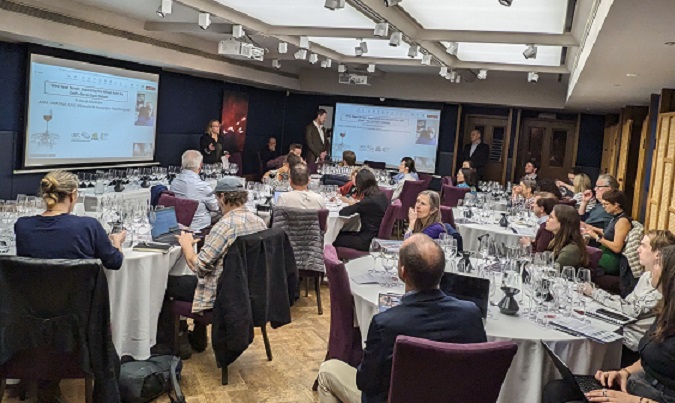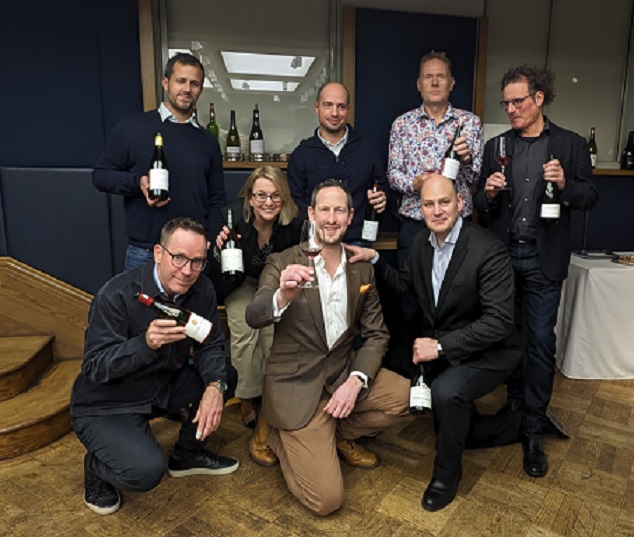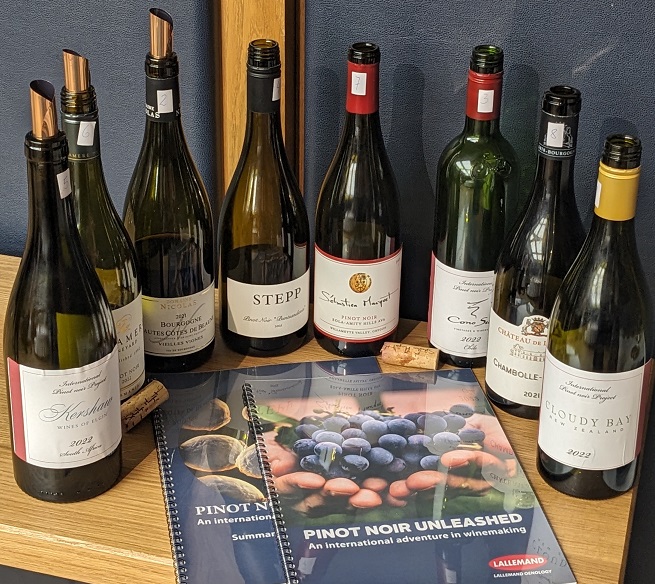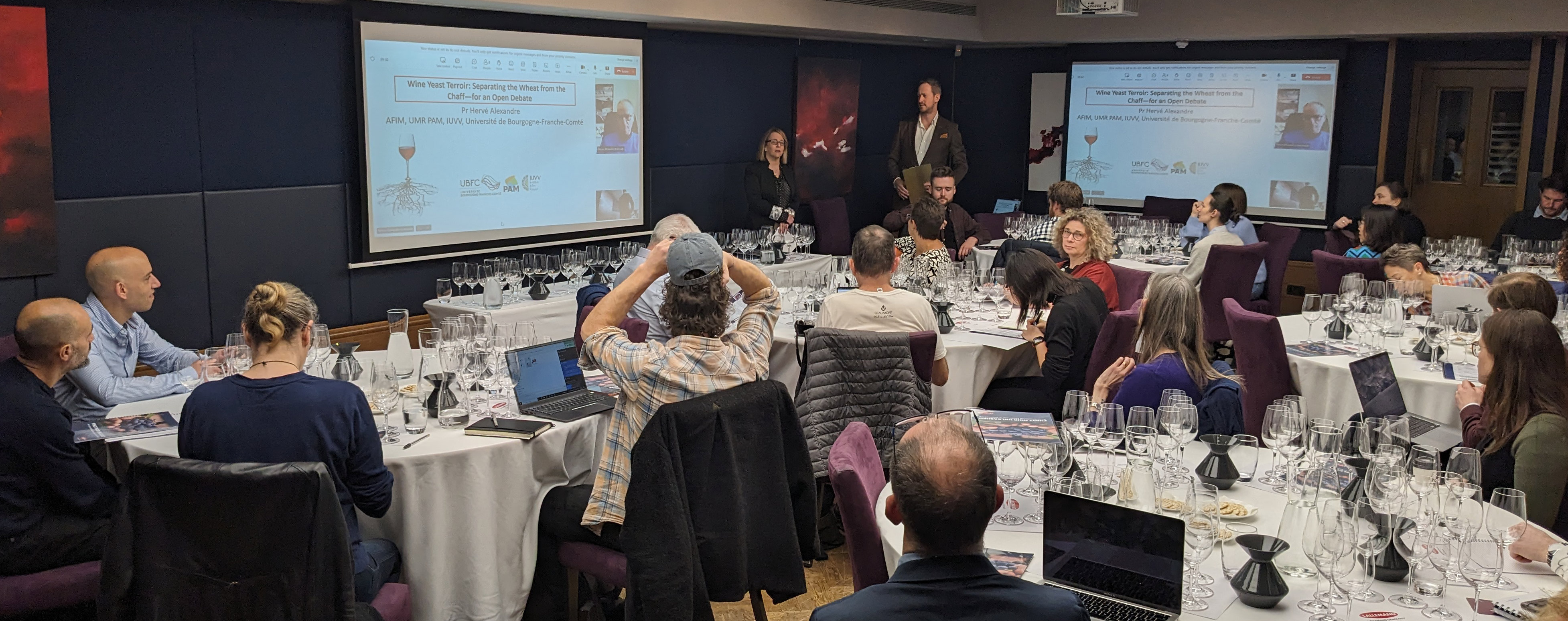- ACHIEVE a consistent flavour profile from vintage to vintage,
- ENHANCE the aromas and flavours of specific grape varieties,
- FERMENT at low temperatures or with high alcohol levels, and
- REDUCE SO2 usage.
I can also see the advantages of native yeasts. They fit in with a low-intervention ‘natural’ winemaking philosophy and have the potential to produce more authentic, expressive and complex wines. And they come free with the grapes.
However, the fermentation may start more slowly and take longer. There is more chance of getting a stuck fermentation, spoilage and off-flavours. In other words, native yeasts are not always as reliable or predictable as commercial yeasts.
This is why I have a foot in both camps – sometimes walking on the wild side; sometimes being more cultured; and sometimes using both options in the same wine (sequential fermentation: starting spontaneously and finishing with selected yeast).
With the various wine projects I initiated in Central and Eastern Europe during my #harvest2022 adventure, I used a mixture of indigenous and cultivated yeasts. And, mostly, I’m happy with those decisions.
The first four wines, which will be launched this year, have turned out very well. The amber wines from Slovenia and Austria were fermented with native yeasts; the sparkling wine from Hungary was produced with cultured yeasts. It’s just the amber qvevri wine from Georgia where I keep questioning the decision to inoculate with red wine yeasts to ferment the indigenous white grapes Kisi and Khihkvi.
Because it’s an amber wine that spent six months on skins in a qvevri in Kakheti, wine lovers expect it to have been produced with native yeasts. They expect it to be a natural wine. But I had one shot at making a wine in a qvevri in Georgia. I couldn’t afford to take any chances. The grapes, from a mixed vineyard, had a potential alcohol of 14-15% and I wanted it to ferment to dryness. I also wanted the fermentation to start as quickly as possible and the wine to spend almost a year in a qvevri without developing off-flavours.
But I still feel guilty when I’m doing tastings and trying to sell the wine. The root of this guilt, I believe, is the notion that you need a spontaneous fermentation with wild yeasts from the same vineyard as the grapes to truly express the terroir.
So, I was very interested in a recent piece of research which “debunks the myth that selected wine yeasts hide the typicity and regionality of wines, and that they lose their sense of place”. The research was funded by Lallemand, a privately-owned Canadian company that specialises in the development and production of yeasts, bacteria and other fungi. But it was carried out with eight of the world’s leading Pinot Noir producers and was the brainchild of Masters of Wine Dirceu Vianna Junior and Sam Harrop, along with Lallemand Oenology’s Ann Dumont.

The results of the study were presented earlier this month during a ‘standing room only’ masterclass and tasting (above) at London’s 67 Pall Mall. The study shows that Pinot Noirs from different regions of the world – even if fermented with the same yeast – are chemically different. The site effect is the main factor separating the wines, giving a real unicity to each wine in the study.
Before the results were revealed, Professor Herve Alexandre from the University of Burgundy set the scene by presenting his most recent research on his specialist subject, the association between microorganisms and terroir. He explained that the notion of terroir yeast is not well defined, nor understood, and that science has yet to fully explain the impact of the microorganism consortium found in the vineyard or winery. He says no study has demonstrated the existence of local yeast or microbial consortium specific to a given terroir.
He points out that alcoholic fermentation is mainly conducted with Saccharomyces cerevisiae; that S. cerevisiae and other yeast species colonise the cellar and have been found to be responsible for alcoholic fermentation, which is called ‘the winery effect’. “Whatever the origin of the grapes, once in the cellar, it will be colonised by yeast species present in the cellar that will ferment together with the grape consortia or displace it.”
He also dismisses the concept of yeast terroir, pointing out that studies have shown variability in the strains of S. cerevisiae conducting fermentation during different vintages and instability of strains from one year to another.
A further dampener on the idea of yeast terroir is the research that has shown wasps spread S. cerevisiae yeast cells in the environment, so the same strain could be found in different terroirs. Research in northern Italy in six sites over three consecutive vintages suggests “the year of isolation (vintage) proved to be a factor that significantly affected the biodiversity of the yeast species, whereas the geographical site (terroir) was not”. A study in 11 wineries in Rioja, Spain, over three or four consecutive years found that yeast strains were different each year in each winery, and hardly any common strains were detected between neighbouring wineries, which would indicate that there are no representative strains from the winery or the area.
While several studies have shown that certain regions have “signature” microbial populations, Prof Alexandre points out that these studies often take samples from the must, so “it is more than likely that winery resident species could have been transferred to the must as it is now well accepted that strains involved in spontaneous fermentation originated both partly from the vineyard and the winery”.
As for the role of non-Saccharomyces yeast, which I’d always believed add complexity and distinction to some wines, Prof Alexandre says: “Curiously, their impact on the final quality of the wine has been poorly characterized. Indeed, while there is a considerable number of studies showing the benefit of using non-Saccharomyces yeasts together with S. cerevisiae in co-culture, there are very few studies showing the contribution of non-Saccharomyces yeasts during indigenous alcoholic fermentation. Thus, the exact role of non-Saccharomyces yeasts present in indigenous fermentation in the final wine composition still requires investigation.”

The new research with the Pinot Noirs came about because Dirceu Vianna Junior MW had come across many examples of bias and misunderstanding with selected yeasts, referencing conversations with professionals who believed the use of inoculated yeasts create specific flavours and are responsible for homogeneity of styles. With clear illustrations of a lack of understanding of the role microbiology plays in the production of wine, Lallemand Oenology agreed to support and fund a study.
Creating a research project to study the impact of using the same wine yeast on Pinot Noir wine production, the goal was to analyse whether the wines would retain typicity, or if individuality would be blurred. Eight wine producers agreed to participate in the experiment.
“We looked at regions around the world producing exceptional Pinot Noir and approached winemakers to participate in the experiment,” explains Harrop. “We wanted to work with producers who were confident and progressive in their winemaking and who were already producing wine with a strong sense of place.”
These producers were instructed to retain their usual winemaking process, with the addition of Lalvin RC212 yeast, which is native to Burgundy and used all over the world for Pinot Noir fermentation. Malolactic fermentation was requested to avoid faults related to Brettanomyces or the production of biogenic amines. For all eight producers, the implantation of the yeasts and the alcoholic and malolactic fermentations were successfully completed without any issues.
After a compound aroma analysis, the study revealed all eight wines showed vastly different aroma compound profiles (esters, terpenes, and norisoprenoids). These differences lead to varying sensory profiles, and aroma intensity.
‘The use of the same yeast strain had not caused homogeneity across the wines’A chemical composition analysis (measured by Metabolomic analysis) which can differentiate samples based on variety, vintage, or region, also highlighted the use of the same yeast strain had not caused homogeneity across the wines.
The conclusion is that this study “clearly” shows that wine from different regions of the world, made from the same variety and fermented with the same yeast, “are chemically different. The site effect is the first factor separating the wine, giving a real unicity to each wine from each producer. Each wines have a specific fingerprint with higher or lower expression of specific compounds compared to average Pinot Noir.”
The wines and winemaking

- 2022 Cloudy Bay Pinot Noir, Marlborough, New Zealand: Aged for 10 months in 30% new oak barrels.
- 2021 Hautes Côtes de Beaune, Domaine Nicolas: Aged for 12 months in 228L French oak barrels, no new barrels.
- 2022 Cono Sur Campo Lindo Pinot Noir, San Antonio Valley, Chile: Matured for 14 months in French oak barrels (228L), 80% second use, 20% new.
- 2021 Stepp Pinot Noir vom Buntsandstein, Pfalz, Germany: Aged for 18 months in second-fill French oak (Jupille forest) barrels (228L).
- 2022 Kershaw Pinot Noir, Elgin, South Africa: Aged for 11 months in 228L French oak barrels (20% new, 30% second fill, 30% third fill, 20% fourth fill) plus one 800L terracotta pot.
- 2022 Delamere Vineyard Pinot Noir, Tasmania, Australia: 30% whole bunches; matured in Burgundy barrels.
- 2021 Sébastian Marquet Bjornson Vineyard Pinot Noir, Oregon, USA: Matured for 11 months in 20% new French oak barrels.
- 2021 Château de Laborde Chambolle-Musigny: Matured for 480 days in 100% French oak barrels (228L); no new oak.













.png)






